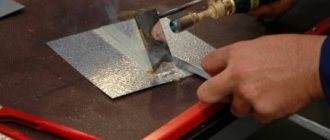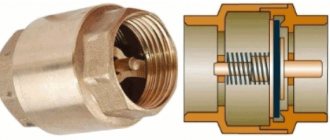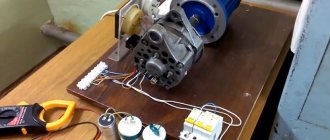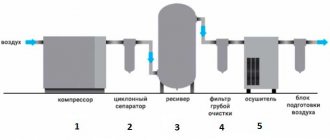Electret microphones are widely used in modern household and special equipment. They are distinguished by their compact size and high quality sound signal transmission. The main disadvantage of the design is the very weak output signal and the mandatory supply of polarizing voltage to the capsule. A preamplifier for a microphone can be made using any element base. Homemade designs use both transistors and integrated circuits. Device circuits differ in the number of stages, the presence of automatic gain control and other technical solutions.
Amplifier for electret microphone
A microphone amplifier for a microphone is used to amplify weak signals of 0.1-15 mV to a level of 200-400 mV. The microphone preamplifier circuit is simple and includes one or two amplification stages and, if necessary, micro frequency response correction circuits. The main design parameters are the following values:
- frequency range
- Harmonic distortion factor
- Signal to noise ratio
- Gain
A good amplifier for micro should provide a frequency range from 20 Hz to 20 kHz with frequency response unevenness no more than ±1.5 dB. The necessary frequency correction is carried out in further low-frequency stages. The harmonic coefficient in the entire frequency range should not exceed 0.2%. Since the microphone device is the first stage, all internal noise will be amplified by the low-frequency path. Therefore, microphone amplifier circuits use the lowest noise transistors and integrated operational amplifiers.
Electrical parameters.
Rated supply voltage – +6V.
Current consumption at Up = 6V, T = -45… +70C, no more than – 5mA.
Voltage amplification factor with internal feedback at Up = 6V, f = 1 MHz, Uin. = 1mV, Rn = 10kOhm, T = +25C:
typical value is 250.
Voltage amplification factor without internal feedback at Up = 6V, f = 1 MHz, Uin = 1 mV, Rn = 10 kOhm, T = +25 C, typical value – 3000.
Normalized voltage of self-noise at Up = 6V, f = 1 MHz, Uin = 1 mV, Rg = 500 Ohm, Rn. = 10kOhm, T = +25C, no more than – 5nV/√Hz, typical value – 2.1nV/√Hz.
Maximum output voltage Up = 6V, Rn = 2kOhm, Kg = ≤ 10%, T = -45C, not less than 0.5V, typical value – 1V.
Upper cutoff frequency at Up = 6V, Rn = 2 kOhm, Ku = 100, T = +25C, typical value – 3 MHz.
Input impedance – 10 kOhm.
Limit operating data.
The maximum supply voltage is 7.5V.
The maximum input voltage is 200mV.
Minimum load resistance (short-term) – 0 Ohm.
Ambient temperature, long-term exposure: –45… +70С, short-term exposure: –60… +125С.
Microphone amplifier for electret microphone
An electret micro with a loud sound produces an output of about 10-15 mV, so to amplify the signal to a level of 400-600 mV, a circuit with one or two stages can be used. The design can be assembled using a conventional or field-effect transistor and an integrated circuit. The microphone amplifier on one transistor is made on a low-noise device with reverse conductivity. The circuit is suitable for use in the audio paths of personal computers. The advantage of the device is its low-voltage power supply and can be powered from a 1.5-volt AA battery. The size of capacitor C3 can be changed within the specified limits.
Additional materials (Download).
The easiest way to make printed circuit boards is using the LUT method. Some varieties of this technology are described here and here.
latest comments
- Sergey on Voltage converter 12 - 220 volts
- ALEXANDER on Ohm's Law
- Evgeniy on the Program “Computer – Oscilloscope”
- Vsevolod on Beginner radio amateur: school, diagrams, designs
- Dmitry on the observer's HF receiver
Read also: Taps and dies dimensions table
Microphone amplifier with one transistor
The field-effect transistor circuit has a low self-noise level and provides a gain of about 20 dB. To do this, it was necessary to increase the supply voltage to 9 V, so the amplifier is powered by a Krona battery or from an external power source. When repeating this circuit, you need to remember that field semiconductor devices are afraid of static electricity, so soldering the transistor must be done with a grounded soldering iron and use an antistatic wrist strap. Before soldering, the leads of the transistor must be connected to each other by wrapping them with thin copper wire. Transistor microphone circuits have various technical solutions. They come with several stages, with automatic gain control and noise reduction.
In the first case, through resistors R4 and R1, the supply voltage necessary for its operation is supplied to the electret microphone. An alternating frequency signal from an electrodynamic device is supplied through capacitor C3 to the base of the transistor. The amplifier for a dynamic microphone is assembled using a single reverse conduction transistor.
Transistor BC547 is replaced by KT3102E. A correctly assembled circuit starts working immediately and does not require adjustment. A microphone amplifier circuit using a single transistor cannot always provide the required parameters, so in practice circuits with a larger number of stages are often used.
An electrodynamic microphone is connected to the microphone amplifier, but the circuit can also be modified for an electret device. To do this, the electrolytic capacitor C2 is replaced with a regular one with a capacity of 4.7 μF, and the supply voltage is supplied to the point of its connection with the micro through a 2-3 kOhm resistor. The gain of the device reaches 200 in the frequency band from 40 Hz to 20 kHz. The use of transistors of different structures made it possible to eliminate the transition capacitor between stages. It usually introduces noticeable distortion into low frequency amplification circuits.
Problem
Most cheap microphones don't have a default sensitivity enough to be heard clearly. You have to scream, but you can’t do that on a regular basis; yelling is a tiresome and harmful activity.
Having carefully studied the issue, I came to the conclusion that the manufacturers are to blame for the situation, overly simplifying the design of the device. Having given his hard-earned 100-500 rubles, the buyer essentially receives a module (capsule) of an electret microphone without any electronic “piping”.
Electret microphone and standard 3.5 mm jack. This design does not allow the microphone to be sensitive, but you can record sound
All sorts of flexible legs and clothespins are optional tinsel. Formally, such microphones work, but their sensitivity and recording quality are low (noise is heard). There's nothing stopping you from adding a few electronic components to the circuit to improve the microphone's ability to pick up quiet sounds.
A typical representative of electret microphones
I'm also not considering purchasing a separate sound card. This was already in the article “How to set up a microphone, record and process sound - instructions for beginners.”
Dynamic microphones already have a built-in amplifier
Amplifier circuits are quite simple, so people who know how to use a soldering iron remake microphones and enjoy life.
Electronics engineers are successfully refining microphones (source)
By the way, even cheap buttonholes for 100 rubles include good electret modules. For example, I have a Genius clip-on microphone from ten years ago, it works great. After modifications, of course.
In addition to low sensitivity, you can hear a low hiss on the recordings. It can be suppressed by filters in an audio editor, but when the interference is too strong, removing noise will distort the useful part of the recording and the voice will sound dull, as if from a barrel.
Read also: How to unscrew a broken bolt
Noise (in 99% of cases this is interference from electromagnetic fields) appears at several stages of sound delivery:
- In the electret capsule of the microphone.
- In the microphone preamp, if available.
- When transmitting a signal via a connecting cable that is not shielded from interference.
- In the sound card amplifier.
The most painful place is the computer's sound card. Replacing with a better one and/or moving it outside the computer case can get rid of the noise, but not everyone has the money for such an upgrade.
Most often, the user is left alone with a cheap microphone plugged into a loud hissing sound card soldered to the computer motherboard. You can try to make the sound louder programmatically.
Microphone amplifier circuit on a chip
There are many microphone amplifier designs on a chip. Most often, devices use operational amplifiers, but there are integrated components that represent a ready-made microphone channel. An example of such a design is the specialized low-noise microphone amplifier microcircuit MAX9814. It has the following parameters:
- Programmable gain – 40, 50 and 60 dB
- Harmonic distortion – 0.04%
- Built-in power supply for electret micro – 2V
- Temperature range – +80- –400С
- Has automatic gain control
For independent repetition, circuits based on integrated op-amps are suitable.
The circuit is assembled on the domestic OU 157UD2. This is a microcircuit with a very low noise level that is not critical to the supply voltage.
The high-quality channel is designed to work with all types of electret microphones. It uses a BA4558 or JRS4558 op-amp. Capacitors C1 and C4 are 0.22 µF each. The circuit is highly sensitive. Does not require adjustment and starts working immediately after supply voltage is applied. The following device uses the K538UN3B microphone chip.
It is very simple, since it does not contain resistors and its assembly requires only a microcircuit and four capacitors. The supply voltage can be reduced to 3 volts without large gain losses. When repeating designs, you need to connect the microphone amplifier with a shielded wire and connect the screen to the device body.
What types of preamplifiers are there?
1. By form factor: built-in and external
, but this was mentioned above.
2. According to the scheme: tube, transistor and modeling
. Tube circuits are traditionally considered “warmer” and “live” in terms of sound compared to transistor ones. But they usually cost more. To notice that special tube sound, the preamp must be in the higher price range. If you want to save money, choose a transistor preamplifier; at an average price, you are unlikely to feel the difference with a tube one.
You can also find a hybrid microphone
a preamplifier that combines tube and transistor components.
Modeling Preamps
are based on transistor circuits, but using digital conversion they simulate the sound characteristics of tube preamplifiers.
3. By the nature of the influence on the signal: coloring and transparent
. Color preamps, as the name suggests, add character to the sound. Typically, they are used by sound engineers in an attempt to add uniqueness to their mixes. Transparent preamps are designed to produce clear sound without any impurities. Typically, these are transistor transformerless preamplifiers.
4. By the presence of a transformer: transformer and transformerless
. The name speaks for itself - either a transformer is present in the family or it is not. Transformer preamps sound fatter, but still color the sound.
Amplifier with microphone input
Low-frequency designs designed to amplify audio frequency signals are always equipped with one or more microphone inputs. These are the most sensitive audio channel inputs. When operating external audio devices, you should avoid connecting devices with high output signal levels to the ULF microphone inputs. This may cause the input transistors or integrated circuits to fail. Professional devices are equipped with XLR connectors that allow you to supply phantom power to condenser microphones.











